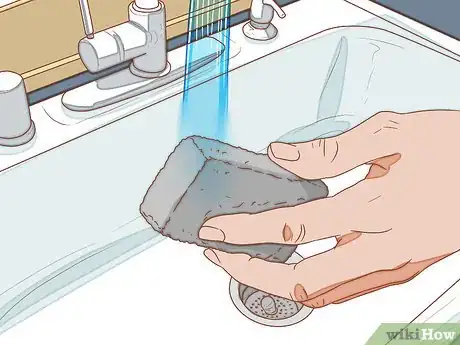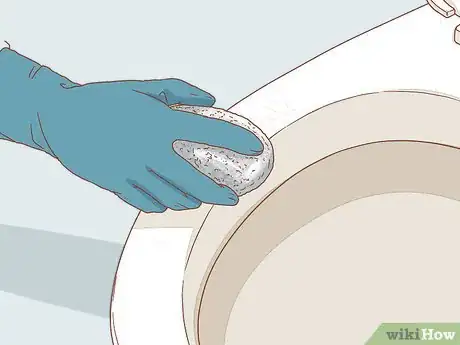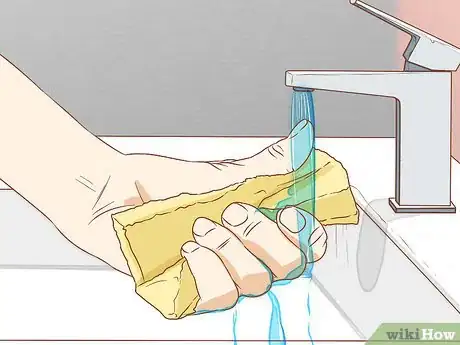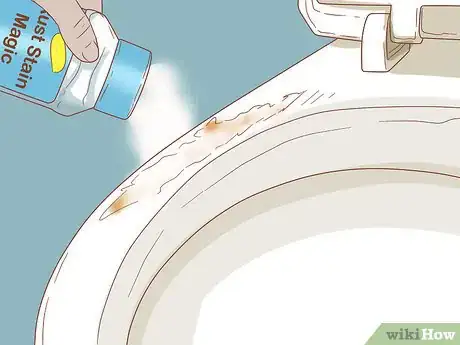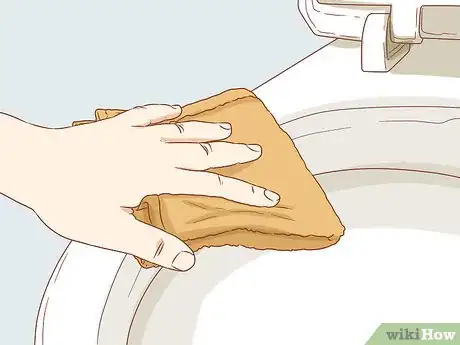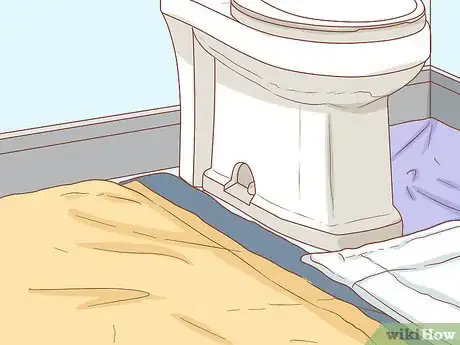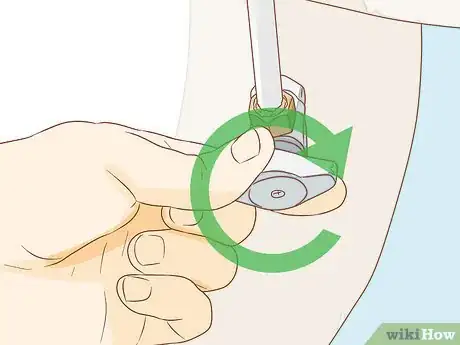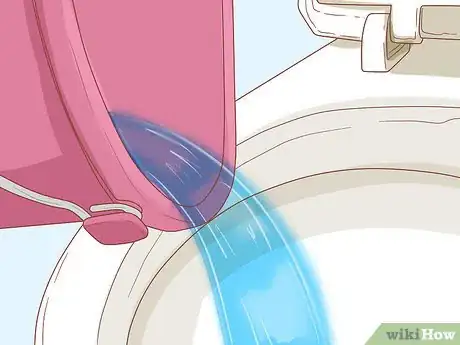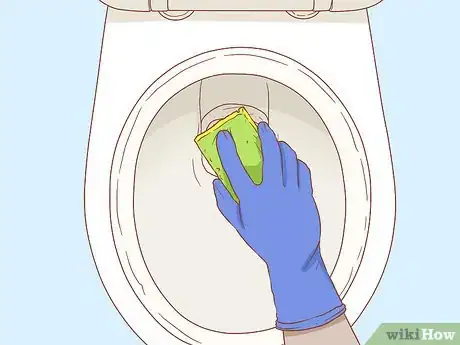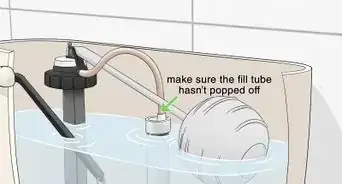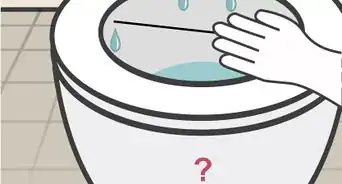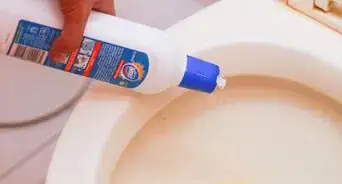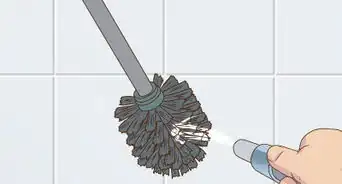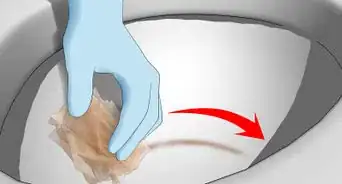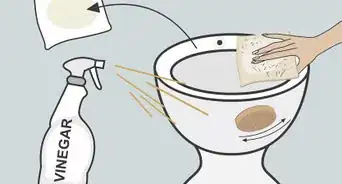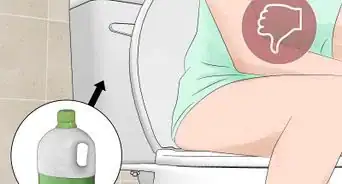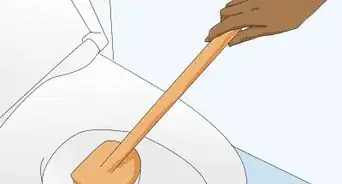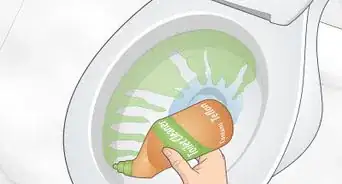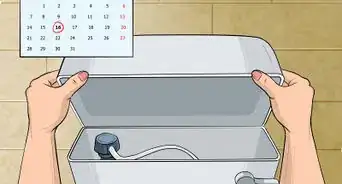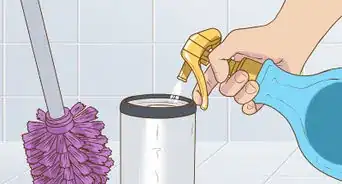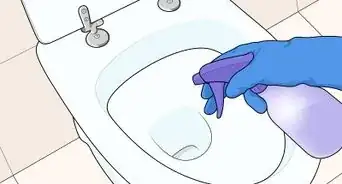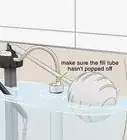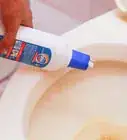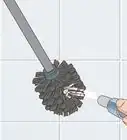This article was co-authored by Michelle Driscoll, MPH. Michelle Driscoll is the Owner of Mulberry Maids, which is based in Fort Collins, Colorado. With five years of experience, her business specializes in cleaning homes and small offices. She holds a Masters in Public Health from the Colorado School of Public Health. Additionally, Mulberry Maids has an A+ rating from the Better Business Bureau.
There are 7 references cited in this article, which can be found at the bottom of the page.
wikiHow marks an article as reader-approved once it receives enough positive feedback. This article received 13 testimonials and 100% of readers who voted found it helpful, earning it our reader-approved status.
This article has been viewed 388,567 times.
Getting metal marks on your porcelain toilet can make it look unkempt and old instead of shiny and clean. Metal marks can come from a variety of sources, including metal toilet brushes and plumber's snakes, but getting rid of them is easier than you might think! If the marks are in the toilet bowl, empty the water out before beginning. Simply use a pumice stone to remove small marks or scrub big scratches and dark marks with an acidic powder. In no time, your toilet will be clean and mark-free.
Steps
Removing Marks with a Pumice Stone
-
1Wet the pumice stone with tap water. Run the pumice stone under tap water to get the outside a little bit wet. A pumice stone is naturally abrasive and porous, so it should absorb water pretty quickly. Just use regular tap water and don't apply any special cleaning solutions to the stone.[1]
- Make sure your toilet bowl is clean before you start removing marks so you don’t spread any germs or bacteria.
- Keep the pumice stone wet at all times to maximize its abrasive cleaning properties. If the stone is too dry, it could scratch the porcelain.
- If you don't have a pumice stone, using a microfiber scouring and cleaning sponge, such as a Magic Eraser, is a viable alternative.
-
2Rub the marks lightly with the stone, applying little to no pressure. Hold the stone so that one end is facing away from you and gently rub the metal marks. Metal marks do not break through the outer porcelain layer and are more like pencil marks on paper than they are deep cuts. You should be able to simply scrub it away within a few moments.
- Don't apply much pressure at all to the pumice stone or you could risk rubbing away the finish on the porcelain.[2]
- The pumice stone will leave a brownish residue as you scrub, which is not permanent and can be removed by running water over it.
Advertisement -
3Rinse off the residue with water or a damp cloth and check again. Pour some water from a bottle into the toilet, or use a damp cloth if the marks are outside the bowl, to wash away the pumice stone residue and check to see if the marks disappeared. If there are marks left, simply go back over them and apply a little bit more pressure to lift them off.[3]
- Big, black marks may require a little more elbow grease, but be careful not to press too hard or you could break the pumice stone or damage the finish on the porcelain.
Using an Acidic Cleansing Powder
-
1Wet an abrasive porcelain-safe sponge with water. Look for an abrasive sponge that is rated for porcelain use. If you use a sponge with metal pieces in the material or a sponge that is not recommended for porcelain use, you could cause much more damage to the toilet than you are trying to fix. Completely drench the sponge so it is dripping.[4]
- The backside to a kitchen sponge usually gets the job done, but be sure to avoid anything that isn't explicitly recommended for porcelain.
-
2Sprinkle the marks with acidic cleanser powder. Pour some acidic cleanser powder on the marks, using just enough to completely cover them up. Don't worry about getting the porcelain wet before scrubbing as the sponge should be wet enough to dissolve and activate the powder's cleaning properties.[5]
- The most popular acidic cleanser for metal marks is Bar Keeper's Friend, although a generic ceramic stove top cleaner or Rust Stain Magic are good alternatives too.
- While Comet and Ajax are common and useful powder cleaners, they are bleach-based and do not clean metal marks as effectively as acid-based powders.
-
3Rub the acidic cleanser powder roughly with the sponge until the mark is gone. Keep scrubbing the mark until you don't see it anymore —as opposed to the pumice stone, you will need to use a lot of pressure to effectively clean the mark away since the sponge works more effectively when pressed pretty hard.[6]
- If your sponge dries out, run it under tap water in the sink and squeeze it to get rid of any excess powder. Then, drench it again and get back to scrubbing!
-
4Wash away the residue and apply more powder to the marks as necessary. Wash away the powder and water residue with a stream of water or a damp cloth and check the marks to see if they have disappeared. If they have, congratulations! If not, pour some more acidic cleansing powder on the persistent marks, clean and re-wet the sponge, and scrub it again.[7]
- Some marks are more "clingy" than others, so it may take a few attempts to get rid of them. Have patience and keep at it.
Emptying the Toilet
-
1Lay towels around the toilet to protect the floor from splashes and residue. Use a couple towels to cover the floor around the toilet's base, even around the back side, to prevent water or cleaning powder from getting on the floor.[8] Don't use new ones, unless you want to have a full load of washing to do — use dirty towels or towels fresh from the shower so you don't create any more laundry.
- Paper towels will work, but you will need to use nearly a full roll to effectively cover the floor around the toilet.
-
2Turn off the water supply to the toilet. Most toilets have a shut-off valve around the rear, so reach back and turn the valve to the opposite side to cut off the water supply.[9] If you don't cut off the water supply, you won't be able to empty the tank and bowl to access the metal marks.
- If your metal marks are on the outside of the toilet only, don't worry about turning off the water supply, as it won't get in the way of your work.
-
3Hold down the toilet handle to drain out all the water from the tank. Take off the tank lid and place it onto a towel, then hold down the toilet handle to flush the toilet and let all of the water drain out from the tank. The water in the bowl should mostly flush away, but there will be some remaining. This process may take several minutes, so get comfortable.
- If your toilet doesn't automatically flush the water running into the bowl from the tank, flush it when it gets full and then continue to hold down the handle.
- As long as nothing is left in the tank, you're ready to move on.
-
4Pour water from a bucket into the toilet to flush it completely. There will still be some water left in the bowl, and the most effective way to get rid of this without flushing it with the handle is to pour about 3 US gal (11 L) of water into the bowl from a bucket. Pour it from a high height, about 2 ft (0.61 m) above the toilet, to simulate the flushing pressure.[10]
- This is where the towels on the floor come in handy, as you are very likely to miss the bowl at first or accidentally splash some out.
-
5Use a large sponge to absorb any remaining water in the tank or bowl. Take a large, dry sponge and dab out any remaining water in the bowl and tank.[11] As long as the marks are uncovered by water, they are ready to be scoured and cleaned away, but get rid of any remaining water as best as you can.
- You may need several sponges to get the remaining water out, so consider buying a multipack of large car washing sponges.
- You can also take this opportunity to clean out the bowl with soap if it is especially dirty, but you will need to simulate flushing again with a bucket of water before you continue with the cleaning process.
- Try sprinkling baking soda on the marks before spritzing them with vinegar. Use a soft cleaning rag to work the marks out.
Community Q&A
Did you know you can get answers researched by wikiHow Staff?
Unlock staff-researched answers by supporting wikiHow
-
QuestionDoes pumice scratch porcelain?
 wikiHow Staff EditorThis answer was written by one of our trained team of researchers who validated it for accuracy and comprehensiveness.
wikiHow Staff EditorThis answer was written by one of our trained team of researchers who validated it for accuracy and comprehensiveness.
Staff Answer wikiHow Staff EditorStaff AnswerIt can, but keeping the stone wet will reduce friction and help prevent scratches. Rub the stone over the porcelain as lightly as you can while still applying enough pressure to remove any stains or debris. You can also soften any stains or buildup first with vinegar or a cleaning solution so you can rub them away more easily.
wikiHow Staff EditorStaff AnswerIt can, but keeping the stone wet will reduce friction and help prevent scratches. Rub the stone over the porcelain as lightly as you can while still applying enough pressure to remove any stains or debris. You can also soften any stains or buildup first with vinegar or a cleaning solution so you can rub them away more easily. -
QuestionWill Bar Keepers Friend work on metal toilet scratches?
 wikiHow Staff EditorThis answer was written by one of our trained team of researchers who validated it for accuracy and comprehensiveness.
wikiHow Staff EditorThis answer was written by one of our trained team of researchers who validated it for accuracy and comprehensiveness.
Staff Answer wikiHow Staff EditorStaff Answer
wikiHow Staff EditorStaff Answer -
QuestionHow do I get rid of snake stains in my toilet?
 wikiHow Staff EditorThis answer was written by one of our trained team of researchers who validated it for accuracy and comprehensiveness.
wikiHow Staff EditorThis answer was written by one of our trained team of researchers who validated it for accuracy and comprehensiveness.
Staff Answer wikiHow Staff EditorStaff Answer
wikiHow Staff EditorStaff Answer
Things You'll Need
Removing Marks with a Pumice Stone
- Pumice stone
- Magic eraser (optional alternative)
- Damp rag or water bottle
Using an Acidic Cleansing Powder
- Abrasive sponge rated for porcelain use
- Damp rag or water bottle
- Acidic cleansing powder, such as Bar Keeper's Friend or a stovetop cleaner
Emptying the Toilet
- Bucket
- Absorbent, non-abrasive sponge
- Towels
- Paper towels (optional alternative)
Warnings
- Don't mix household cleaners, especially ammonia-based cleaners and bleach-based cleaners. If you have recently bleached or cleaned the toilet, wash it out with a few flushes or wipe it down with a damp rag a few times before you use acidic cleansing powder.⧼thumbs_response⧽
- Wear rubber gloves when working in or around the toilet to protect yourself from chemicals and germs.⧼thumbs_response⧽
References
- ↑ https://youtu.be/-ajcPJwMuQg?t=257
- ↑ https://youtu.be/-ajcPJwMuQg?t=275
- ↑ https://youtu.be/-ajcPJwMuQg?t=301
- ↑ https://youtu.be/B4LOeMuCn7o?t=18
- ↑ https://youtu.be/B4LOeMuCn7o?t=51
- ↑ https://youtu.be/B4LOeMuCn7o?t=72
- ↑ https://youtu.be/B4LOeMuCn7o?t=72
- ↑ https://www.bobvila.com/articles/how-to-drain-a-toilet/
- ↑ https://www.bobvila.com/articles/how-to-drain-a-toilet/
About This Article
To clean metal marks off a porcelain toilet, try using an acidic cleanser powder. Sprinkle the powder over the marks on your toilet. Then, rub it with a damp sponge until the marks are gone. Wipe away any residue with a damp cloth. Alternatively, get rid of the marks with a pumice stone. First, wet the stone under the faucet. Then, gently rub it on the porcelain marks. You may need to repeat the process a few times to completely get rid of the marks. To deal with any residue left by the pumice stone, just wipe the surface with a damp cloth. For more tips from our Cleaning co-author, including how to empty your toilet bowl to clean inside, read on.
